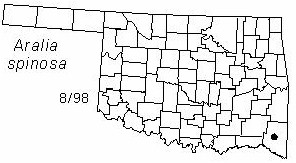Spiny shrub or sometimes small tree to 15 cm (6 in) in diameter. Twigs very thick, light brown, glabrous, with many straight sharp spines especially at the nodes. Bark on larger stems dark brown, thin, fissured into broad flat forking ridges. Buds large, conical, brown, with a few scales. Leaves clustered at ends of twigs, bipinnately compound, 40-75 cm (16-30 in) long, primary rachis prickly and clasping the twig at base. Ultimate leaflets numerous, mostly paired, short-stalked, ovate to broadly elliptical, 5-9 cm (2-3.6 in) long and 3-4 cm (1.2-1.6 in) wide, acuminate, finely serrate, dark green above, lighter below, often with prickles on the midvein below. Flowers white, 5-petaled, many, very small, in a large cluster consisting of umbels in a panicle 20-40 cm (8-16 in) long, flowering in Summer. Fruits numerous black drupes about 6 mm (0.25 in) in diameter, maturing in late Fall.
Distribution: Native to about the southeastern third of the U. S., but escaping from cultivation over much of the eastern half of the country.
Habitat: The natural habitat seems to be moist bottomland forests, but upland plantings often persist and spread.
NWI status: FAC
Comment: The natural distribution was probably as shown below, but it persists from plantings further north and west. The seeds are eaten by birds and the foliage is browsed by deer. The genus name, Aralia, is derived from the French-Canadian common name; spinosa refers to the numerous spines on the stems.
Distribution in Oklahoma: 
BACK
NEXT
RETURN TO INDEX
Last update: 9/8/99
 Go to Oklahoma Biological Survey Home Page
Go to Oklahoma Biological Survey Home Page
 Disclaimer
Disclaimer